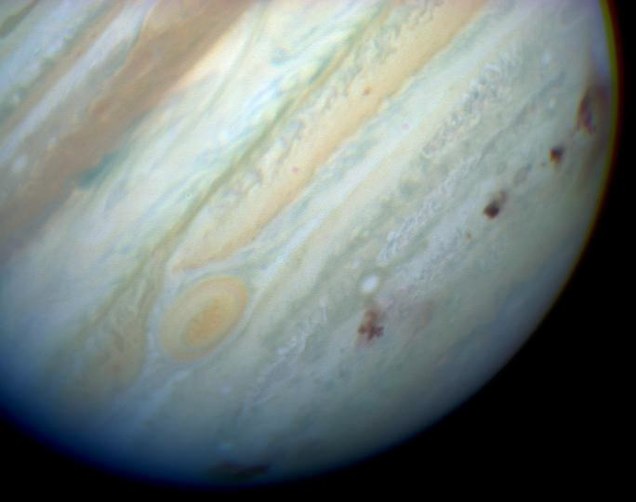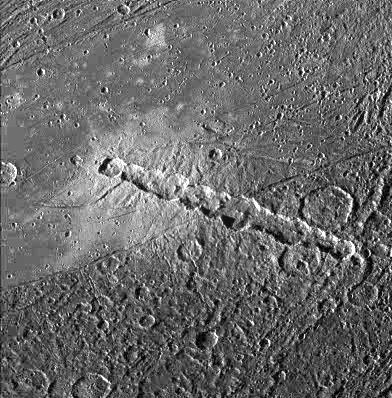This is why the earth has high and low tides. The parts of the earth closer to the moon feel a stronger gravitational force from the moon than the parts further away. This causes the oceans to "bulge" and the tides to rise or fall in different parts of the earth. (Again, see the above picture.)
 Ripping Objects Apart.
Ripping Objects Apart.If tidal forces are strong enough, they can actually do more then make the object bulge, they can rip the object apart. Perhaps the most classic example of this is the Comet Shoemaker-Levy 9.
This comet got too close to Jupiter in 1994 for it own good. The picture above this section is an actual photograph of how the comet was ripped apart into a string of pearls. As you can see tidal forces can be strong enough to cause a lot of damage.

The picture to the above right in this section shows the impacts on Jupiter when this string of pearls was finally brought in by gravity.
The picture to the low left of this section shows a crater structure on Ganymede (On of Jupiter's moons) that scientists believe was caused by an object like the above comet that was similarly ripped into a string of pearls.
Ripping Planets Apart.
Some planets come too close to their host star. When the planets are gaseous like Jupiter, the star can suck in gases through tidal forces. In this way the planet slowly gets "eaten". This is also called accretion.
As reported by Scientific American, astronomers have recently found a planet eaten by the host star.
The picture to the right demonstrates this planet being devoured.The giant planet WASP 12 b, discovered in 2008, orbits its star at the uncomfortably close distance of only about 3.4 million kilometers... the planet so close to its star, that WASP 12 b is likely losing mass rapidly to its star... [a] group modeled WASP 12 b's mass loss, finding that it gives away roughly one ten-millionth of its total mass each year... Given WASP 12 b's heft, some 1.4 times the mass of Jupiter, that would mean that the scorching world loses as much mass in just seven years as is contained in all of Earth's oceans.


I wonder how long the planet had been there. It seems like something must have perturbed its orbit closer to the star. Why else would the planet have a chance to form and then get eaten?
ReplyDeleteStan,
ReplyDeleteGood question. Nick or Quantumleap42 may know better about this particular thing now that they have passed their Astro quals. :)
It is my understanding that something would have needed to bring the object closer to it's star, otherwise I would think the planet would have had a hard time forming in the first place. I have no idea what it was in this case.
I was deeply saddened to learn that the final photo above was an artist's rendition. Tidal forces are killer!
ReplyDeleteStan and Joe,
ReplyDeleteIt looks like in this case the host star, creatively named WASP 12, is a subgiant that has left the main sequence, meaning it has no more hydrogen in it's core and fusion is now taking place in a shell. This means that the radius of the host star has been slowly expanding for something like 50 million years. So probably the plant hasn't moved inwards, the star has expanded.
That does, however, mean that the Jupiter-sized planet was well inside of the orbit of Mercury for billions of years. It's a completely different question to ask how giant planets get so close to their parent stars in the first place. It turns out it's actually fairly easy if you can use other planets or a proto-stellar disk, but it's an open question.
Thanks Nick, that makes perfect sense. It is weird to think that is probably the Earth's fate too, if we don't get blasted by a wandering brown dwarf, fried by a close super Nova or hauled off to Kolob first. =:)
ReplyDeleteNick,
ReplyDeleteThanks for elaborating on this.
Ben,
ReplyDeleteSorry, I should have noted it was an artist's rendition.